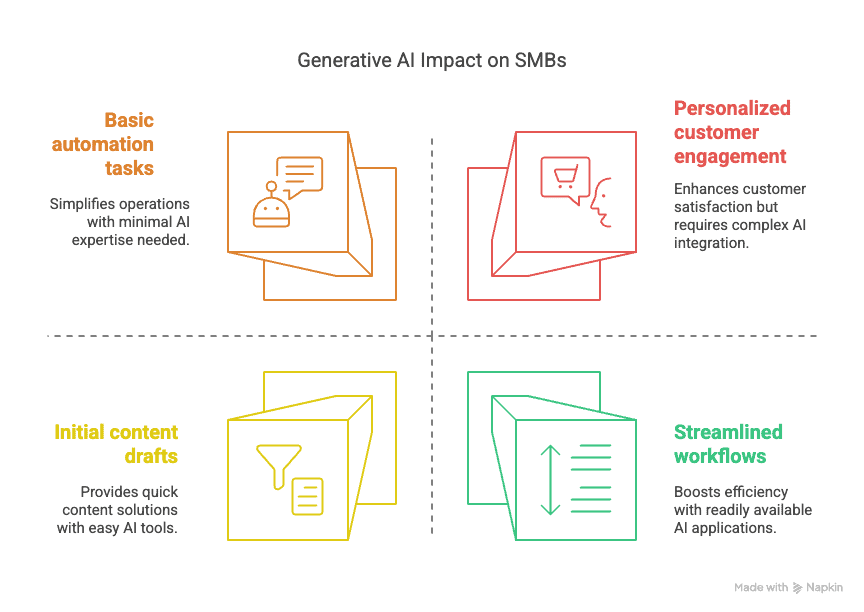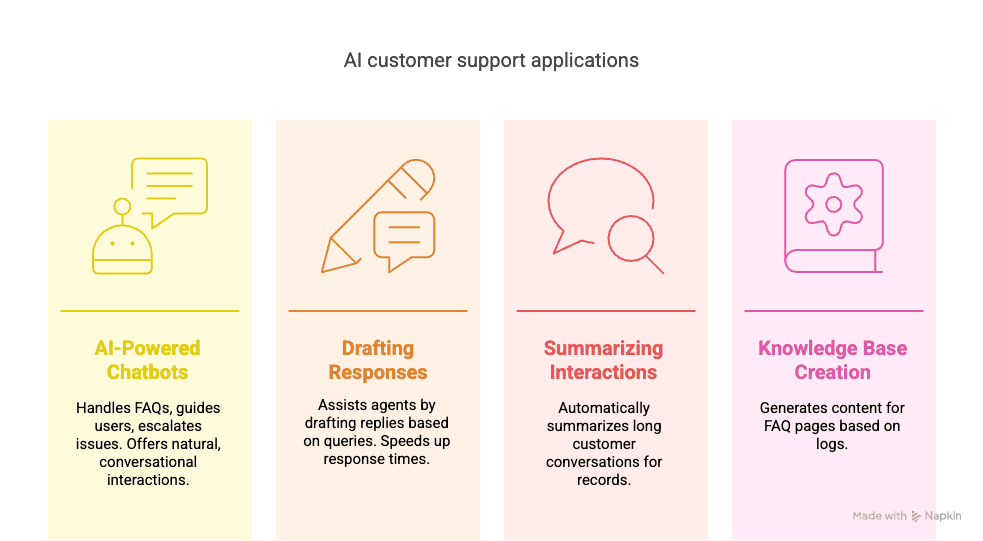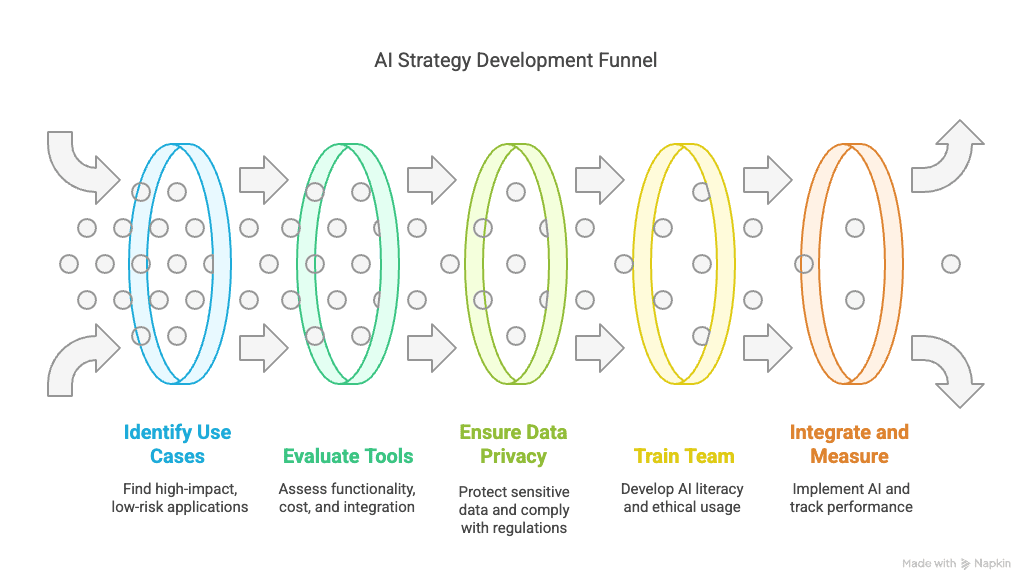Generative Artificial Intelligence (AI) has moved rapidly from a novel curiosity to a pervasive technology discussed in boardrooms and breakrooms alike. While the initial hype surrounding tools like ChatGPT captured global attention, the conversation in 2025 is shifting towards practical application and tangible business value. For small and medium-sized businesses (SMBs), understanding how to leverage generative AI strategically is becoming less of an option and more of a necessity to maintain competitiveness, enhance efficiency, and unlock new avenues for growth.
This article moves beyond the hype and examines actionable strategies for small to medium-sized businesses (SMBs). We'll explore specific use cases, outline steps for developing an AI strategy, discuss critical considerations such as data privacy and ethics, and provide a brief look at the future landscape. Whether you're a tech enthusiast tracking the latest developments or an SMB leader seeking practical guidance, this piece aims to offer helpful, fluff-free information.
Why Generative AI Matters for SMBs *Now*
For years, advanced technology often felt like the exclusive domain of large enterprises with deep pockets and dedicated R&D departments. Generative AI, however, presents a different paradigm. Its increasing accessibility through cloud platforms and integrated software tools offers SMBs powerful capabilities previously out of reach. Here’s why it’s particularly relevant now:

- Democratization of Capabilities: Many generative AI tools are available through subscriptions or are being integrated into existing business software, such as CRMs, marketing suites, and productivity tools, thereby lowering the barrier to entry. SMBs can now access sophisticated content generation, data analysis, and automation tools without requiring extensive in-house AI expertise or massive datasets for training, as many models are pre-trained.
- Addressing Resource Constraints: SMBs constantly juggle limited time, budget, and personnel. Generative AI can serve as a powerful force multiplier, automating repetitive tasks, accelerating content creation, generating initial drafts for reports or communications, and handling routine customer inquiries. Recent studies indicate that businesses adopting AI report significant time savings, freeing up valuable human resources for higher-level strategic work.
- Boosting Productivity and Efficiency: From summarizing long documents and meetings to generating code snippets and optimizing marketing copy, AI can streamline numerous workflows. Businesses leveraging these tools often report notable increases in efficiency across various functions.
- Enhancing Customer Engagement: AI enables personalization at scale, a feat once considered difficult for small to medium-sized businesses (SMBs). It can help analyze customer data to tailor marketing messages, power chatbots for instant responses, and even draft personalized follow-up communications, leading to improved customer satisfaction and loyalty.
- Leveling the Competitive Landscape: By adopting AI strategically, small to medium-sized businesses (SMBs) can enhance their offerings, operate more efficiently, and respond more quickly to market changes, enabling them to compete more effectively with larger players. Research suggests that a significant percentage of businesses are already exploring or actively using AI, indicating a trend toward adoption to maintain parity.
Key Application Areas for Generative AI in SMBs
The potential applications of generative AI are vast. For SMBs, the key is to focus on areas where it can deliver the most significant impact relative to the investment and effort. Here are some core areas:
1. Content Creation and Marketing
This is perhaps the most widely recognized application. Generative AI tools can significantly accelerate content workflows:
- Drafting Content: Generating initial drafts for blog posts, articles, website copy, email newsletters, and product descriptions based on prompts and outlines. Human editing and refinement remain essential for ensuring quality, maintaining a consistent brand voice, and ensuring accuracy.
- Social Media Management: Creating post ideas, drafting captions tailored to different platforms, suggesting relevant hashtags, and even scheduling content.
- Marketing Copy & SEO: Generating variations for ad copy (e.g., Google Ads, Facebook Ads), suggesting SEO-optimized titles and meta descriptions, and brainstorming keywords.
- Idea Generation: Brainstorming campaign ideas, content topics, and marketing angles based on target audience profiles or industry trends.
- Visual Content (Emerging): Tools capable of generating images or suggesting design layouts for presentations and marketing materials are becoming increasingly accessible, although they often require careful prompting and selection.
Example: An SMB marketing team could use a tool like Gemini or Claude Ai, or the integrated AI features within their marketing platform, to generate five different email subject lines for a campaign, get an outline for a blog post on a specific topic, and draft three social media posts promoting that blog post, all within an hour – tasks that might previously have taken half a day.
2. Customer Service and Support
Improving customer interactions and response times is vital for SMBs:

- AI-Powered Chatbots: Handling frequently asked questions 24/7, guiding users through simple processes (like order tracking), and escalating complex issues to human agents. Modern AI chatbots provide more natural and conversational interactions than older, rule-based systems.
- Drafting Responses: Assisting support agents by drafting replies to customer emails or support tickets based on the query and internal knowledge bases. This speeds up response times while allowing agents to personalize and verify the information.
- Summarizing Interactions: Automatically summarizing long customer conversations (calls or chats) for internal records or agent handovers.
- Knowledge Base Creation: Helping to generate and structure content for internal or external FAQ pages and knowledge bases based on existing documentation or support logs.
Example: A small e-commerce business could implement an AI chatbot (such as Tidio) or integrate one via their e-commerce platform, like Shopify, to instantly answer common questions about shipping times and return policies, thereby reducing the load on their small support team and improving customer satisfaction.
3. Sales Enablement
Supporting the sales team to be more effective:
- Personalized Outreach: Drafting tailored email templates or LinkedIn messages based on prospect profiles or company information.
- Sales Script Generation: Creating initial drafts for sales call scripts or talking points for different customer segments or product offerings.
- Meeting Summaries: Generating summaries and action items from recorded sales calls or meetings (tools like Otter.ai).
- Lead Qualification (Basic): AI integrated into CRM systems can sometimes help score leads based on engagement data or predefined criteria, helping prioritize efforts.
4. Internal Operations and Productivity
Streamlining day-to-day tasks is a significant benefit:
- Document Summarization: Quickly summarizing long reports, research papers, or internal documents to grasp key points.
- Meeting Assistance: Generating agendas, transcribing meetings, summarizing discussions, and identifying action items.
- Drafting Internal Communications: Creating first drafts of internal memos, announcements, policies, or project updates.
- Data Entry & Organization (Task-Specific AI): While general generative AI might assist with formatting, more specialized AI or RPA (Robotic Process Automation) tools often handle high-volume data entry or migration tasks. However, GenAI can help structure unstructured information for easier processing.
- Code Generation & Debugging (for tech-focused SMBs): Assisting developers by generating code snippets, explaining code blocks, identifying bugs, and suggesting fixes (e.g., GitHub Copilot, Gemini Code Assist).
- Spreadsheet Assistance: Helping organize data, create formulas, or generate charts in tools like Google Sheets or Excel with integrated AI features.
Example: An SMB manager could use AI to summarize a lengthy industry report before a strategy meeting, saving hours of reading time. They could also utilize an AI meeting assistant to capture notes and action items from the meeting automatically.
5. Data Analysis and Insights (Emerging but Growing)
While complex BI often requires dedicated tools, generative AI is making basic data interpretation more accessible:
- Analyzing Customer Feedback: Summarizing trends and sentiment from large volumes of customer reviews or survey responses.
- Generating Reports from Data: Creating narrative summaries or identifying key takeaways from structured data sets (e.g., sales figures, website analytics) when prompted correctly.
- Market Trend Analysis: Assisting in summarizing research reports or articles about market trends, although human validation is critical here.
Developing an AI Strategy for Your SMB
Implementing AI effectively requires more than just signing up for a few tools. A strategic approach is crucial to maximize benefits and mitigate risks.

1. Start with Business Objectives, Not Just Technology
Before diving into AI tools, clearly define the business problems you want to solve or the goals you want to achieve. Are you trying to reduce customer support response times? Increase marketing content output? Improve internal reporting efficiency? Aligning AI initiatives with specific, measurable business objectives ensures that technology serves a purpose rather than becoming a distraction.
2. Identify High-Impact, Low-Risk Use Cases
Don't try to overhaul everything at once. Start with small pilot projects in areas where AI can provide clear value with relatively low complexity and risk. Automating internal summaries or drafting social media posts might be safer starting points than deploying an AI for critical financial analysis or unsupervised customer interactions. Success in these initial projects builds confidence and understanding, paving the way for broader adoption.
3. Evaluating and Selecting AI Tools
The market is flooded with AI tools. Consider these factors when choosing:
- Functionality: Does it effectively address the specific task you identified?
- Ease of Use: Can your team learn and use it without extensive technical expertise?
- Integration: Does it integrate with your existing software stack, such as CRM or marketing platforms? Seamless integration is often more valuable than a standalone tool.
- Cost: Does the pricing model (subscription, usage-based) fit your budget? Understand the total cost of ownership.
- Data Privacy & Security: This is paramount. Scrutinize the vendor's policies (see next point).
- Scalability: Can the tool grow with your needs?
Focus on tools tailored for SMBs or those integrated into platforms you already use.
4. Prioritize Data Privacy and Security
This cannot be overstated. Feeding sensitive customer or proprietary business data into external AI models carries significant risks. Understand:
- How your data is used: Does the vendor use your prompts or data to train their general models? Opt for solutions that offer data privacy controls or private instances if handling sensitive information.
- Compliance: Ensure the tool and your usage comply with regulations like GDPR, CCPA, HIPAA, or industry-specific requirements.
- Vendor Security: Assess the vendor's security practices and certifications.
- Internal Policies: Establish clear guidelines for your employees on what data can and cannot be used with specific AI tools. Avoid inputting confidential information into public AI models.
5. Foster AI Literacy and Upskill Your Team
AI tools are most effective when users understand how to interact with them. Invest in training:
- Prompt Engineering Basics: Teaching staff how to write clear, effective prompts to get desired outputs.
- Understanding Limitations: Educating users about potential inaccuracies (“hallucinations”), biases, and the need for human review.
- Ethical Use: Training on responsible AI usage, including avoiding bias amplification and ensuring transparency where appropriate.
- Tool-Specific Training: Familiarizing the team with the features and best practices of the specific AI tools being implemented.
Research indicates a gap in employee readiness for AI; proactive training is essential.
6. Integrate, Measure, and Iterate
AI implementation is not a one-time event. Integrate the chosen tools into relevant workflows. Define key performance indicators (KPIs) to measure the impact – are response times decreasing? Is content output increasing? Is employee time being saved? Regularly review the results, gather feedback from your team, and be prepared to adjust your strategy, tools, or processes based on the insights you gain.
Navigating the Challenges and Ethical Considerations
While generative AI offers immense potential, SMBs must be aware of the challenges and ethical considerations:
- Accuracy and Hallucinations: AI models can generate incorrect, misleading, or nonsensical information, often referred to as “hallucinations.” Human oversight and fact-checking are non-negotiable, especially for external communications or critical decisions. Never trust AI outputs blindly.
- Bias: AI models are trained on vast datasets, which can contain societal biases. These biases can be reflected or even amplified in the AI's output. Be critical of generated content and strive for fairness and inclusivity in your applications.
- Intellectual Property (IP) and Copyright: The legal landscape around AI-generated content is still evolving. Be cautious about using AI to generate content that might infringe on existing copyrights. Understand the terms of service of the AI tools regarding ownership of generated content. Avoid inputting proprietary intellectual property (IP) into models that might learn from it.
- Job Role Evolution: While AI can automate tasks, the focus should be on augmentation – freeing up employees for more complex, creative, and strategic work. Open communication about how AI will be used, along with investment in upskilling, can help alleviate concerns about job displacement.
- Overreliance: Relying too heavily on AI for tasks that require critical thinking, creativity, or nuanced judgment can erode skills over time. Balance AI assistance with human expertise.
- Transparency: Consider when it's appropriate or necessary to disclose the use of AI, particularly in customer interactions or content creation, to maintain trust.
The Future Outlook: What's Next for AI and SMBs?
The field of generative AI is evolving at an unprecedented rate. For SMBs, key trends to watch include:
- Deeper Integration: Expect AI capabilities to become seamlessly embedded within more business software, making them feel less like separate tools and more like standard features.
- Multimodal AI: Models that can understand and generate content across multiple modalities, including text, images, audio, and video, will become increasingly common, opening up new applications (e.g., analyzing product photos and generating video scripts with scene suggestions).
- AI Agents: The concept of AI agents performing multi-step tasks autonomously (e.g., booking travel, managing complex scheduling) is developing, although practical, reliable applications for SMBs may still be emerging.
- Specialized Models: AI models trained for specific industries or tasks (e.g., legal document review, medical transcription) may offer higher accuracy and relevance than general-purpose models.
- Increased Focus on Governance and Trust: As adoption grows, expect greater emphasis on tools and frameworks for managing AI responsibly, ensuring security, privacy, and ethical use.
Conclusion: Embracing AI Strategically
Generative AI represents a significant technological shift, offering SMBs powerful tools to enhance productivity, creativity, and customer engagement. It has the potential to automate routine work, provide valuable assistance, and unlock insights previously hidden within data. However, realizing these benefits requires moving beyond the hype and adopting a thoughtful, strategic approach.
By carefully identifying business needs, selecting the right tools, prioritizing security and ethics, investing in employee training, and continually iterating, SMBs can effectively harness the power of generative AI. It's not about replacing humans but augmenting their capabilities, allowing small and medium-sized businesses to operate more efficiently, compete more effectively, and focus on delivering unique value in an increasingly AI-driven world. The journey starts with understanding the possibilities and taking measured, purposeful steps forward.
What are your experiences or concerns about using generative AI in your business? Share your thoughts in the comments below!